Sometimes I really feel thankful to the stars for giving me an opportunity to live in the North East India. It is a real bliss for me to live in Guwahati and explore the North Eastern States one after another, slowly and progressively. It is my quest to visit Mizoram that brought me to Imphal first time. That time there was only one flight operating between Kolkata and Aizawl, the capital of Mizoram, but the flight was very expensive, so I booked a more bargain flight to Imphal, the capital of Manipur. From Imphal, it was a cumbersome 20-hours road journey via Jiribam, Silchar by shared jeeps to Aizawl, but it helped me navigating through the remotest corner in a relatively remote part of India. It was during that trip I enjoyed the hospitality of Mizo people and considered them one of the most lovely people in India. I will talk about my Mizoram trip later in another post.
Read here about Shillong, Another vibrant city from North East India: The Most Vibrant City Of North East India
Time flied fast and two years later, I found me again in Imphal, on a motorcycle, riding through the state of Nagaland and Manipur. The first wave of Covid had been already caused the havoc throughout the world, and after 7 months of self-imposed lockdown at home, I stared travelling from December onwards. I decided to ride through Nagaland and Manipur in the month of March-April when chance of the rain is moderately less in that part. Little I was aware that the rain would play a spoilsport throughout my journey in Nagaland and the fatal second wave of Covid-19 was just a month away.
Contents
3. World War II Cemeteries in Imphal
4. Eco-Tourism Picnic Spot at Cheirao Ching
11. Strawberry Farms
Braving the continuous rain, I travelled across Nagaland and entered in Manipur through Mao Border. A day later, I found myself in the city of Imphal. Imphal of the second time was a bit familiar to me. At least, I was aware about the accommodation, food and notable attractions of the city. I went straight to the Youth Hostel near Khuman Lampak Stadium and reserved a room for 4 nights. My intention was to stay in Imphal while taking a daily ride to the tourist places like Moreh Border, Loktak Lake and Ukhrul. I planned to spend one night each at Loktak Lake and Ukhrul also.
1. Ima Market in Imphal
As expected, my trip to Imphal started with a visit to Ima Market, the all women market in the heart of the city. Amidst the chaos of bustling city, Ima Market (Ima Keithel) looks like an ordinary weekly market thronged by hundreds of locals and tourists alike where vendors sell groceries, clothes, fruits, toys, spices, utensils, fishes and everything else. But there is something extraordinary about this market. It is an all women’s market where approx 5000 local women wrapped in traditional phaneks, innaphis and sarees set their shops and stalls every morning to welcome a substantial number of shoppers. These women handle all the chorus at three shopping complexes of the Ima Market, spread across the both side of the road, together with hundreds more informal vendors in the outside street and under the flyover. This market occupies a unique tradition in the history of Manipur.
History of the market dates back to the 16th Century. A forced labour system (Lallup System) in Manipur expected the male members of the Meitei Community to work in the distant land or to serve in the army. Back home, the women had no choice, but to manage the households on their own. They started supporting their households by cultivating their fields or weaving textiles and then selling the products on local markets.
Coming back to the modern era, Manipur is still lacking far behind in terms of good education, local industries and youth employment. Most young people leave the state in search of either education or work. It leaves women with no choice, but to work for their daily expenditure. In situation like this, the tradition of Ima Market continued to thrive over the years.
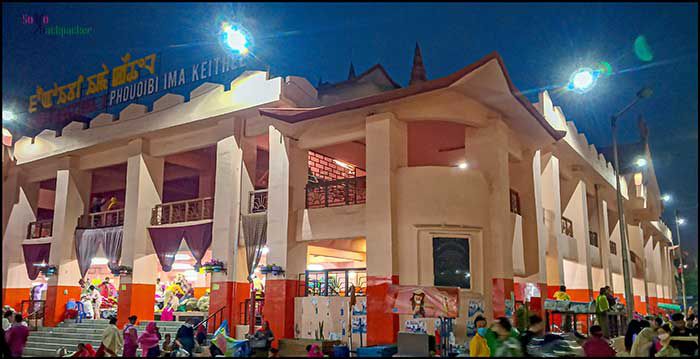
The market maintains a custom of only allowing women who have been married at least once to set up stalls including divorced and widowed. They are called as Ima (Mother). The Imas of Manipur is just the ordinary women doing some extraordinary things.
Ima Market can be considered as a glorious symbol of Women Empowerment, not only in Manipur, but in entire India despite the fact that all the women shopkeepers there tried to make their day end living by selling some stuffs, often at a throwaway price. Despite all the odds, all the glory; the truth is they had to work hard to keep their life running at the end. Where is the Women Empowerment then? May be in the fact that they are at least fighting hard to run the show of their lives.
Apart from being a shopping market, Ima Market also represents a rather strong socio-political institution in the history of Manipur. In fact, the ordinary women from Manipur keep doing many extraordinary things in the course of the Manipuri History. They stood fearless against the British Force in 1904, when the men of Imphal were ordered to carry wood and bamboo from Kabow Valley in Burma and reconstruct the fire-ravaged residence of Major Maxwell, the British Political Agent after re-introducing the forced labour system (Lallup System). The men were required to perform free labour for 10 days after every 30 days. The women marched on the streets in a large number to protest, refusing to move till the order was retracted. They had to be dispersed by the use of force, but ultimately the order was withdrawn. This event is known as the first Nupi Lan (Women’s War) in the history of Manipur.
The second Nupi Lan in 1939 was triggered by the policy of exporting rice at a time when Manipur was on the verge of a famine. The women again came out on the streets of Imphal demanding a ban on rice export and a closure of rice mills. For several months, they stood unarmed but strong against the military before the movement ended with the outbreak of World War I. Later, a Nupi Lan Memorial Complex was constructed in Imphal as a tribute to the courageous Manipuri women, who sacrificed their lives fighting for justice against the British.
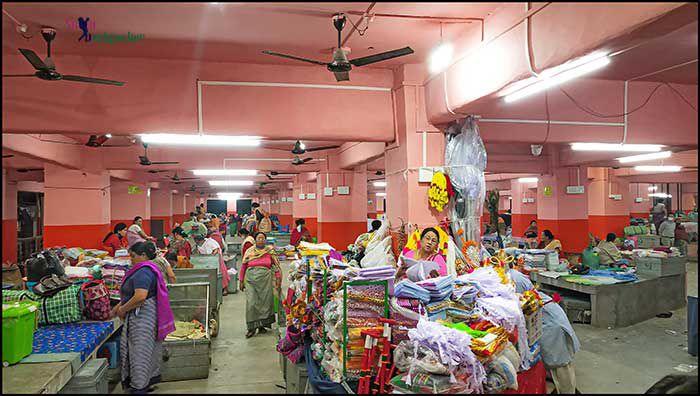
Throughout the history, Manipuri women have bravely led protests across the years, be it the Meira Paibi movement in the 1970s against the drug abuse and alcoholism or the 12 women standing nude in front of the Kangla Fort in 2004 to protest against the Armed Forces (Special Powers) Act (AFSPA), after alleged rape and brutal murder of Manorama Devi by the soldiers of Assam Rifles. Most of these women are connected with the Ima Market. This is the place where bonds get shared, ideas get exchanged, social norms get discussed and strong protests get shaped, all while managing a spectacular show of financial freedom.
2. Visit to Kangla Fort
The subsequent stop of my trip was Kangla Fort, a sprawling complex spread in the area of 237 acres. Kangla Fort remain the traditional seat of the past Metei rulers of Manipur. The history of the fort dates back to 15th century. It has witnessed many events in the history of Manipur. After Anglo-Manipur War, the fort was occupied by the British forces in 1891. When India achieved independence in 1947, the fort was occupied by Assam Rifles. Throughout its history, it underwent various phases of demolitions and reconstructions by Metei Rulers, Burmese, British, Indian Armed Forces and the Government of Manipur.
Its occupation by the Assam Rifles remain a critical source of discontent of the local people. The fort was believed to be a major interrogation center, where local people was detained under the notorious AFSPA. Since the inception of AFSPA in 1980s, there has been countless demand by local community to repeal the act, that has given immense power to the armed forces to shoot, arrest and search- all in the name of maintaining the public order. The army can shoot to kill; it can enter and search without a warrant and it can destroy property.
Many protests were organised in Imphal to repeal the draconian act without any fruitful result. The protestors also demanded the shifting of Assam Rifles Headquarter from the Kangra Fort. After many protests and demonstrations, the fort was finally handed over to the Government of Manipur in November, 2004.
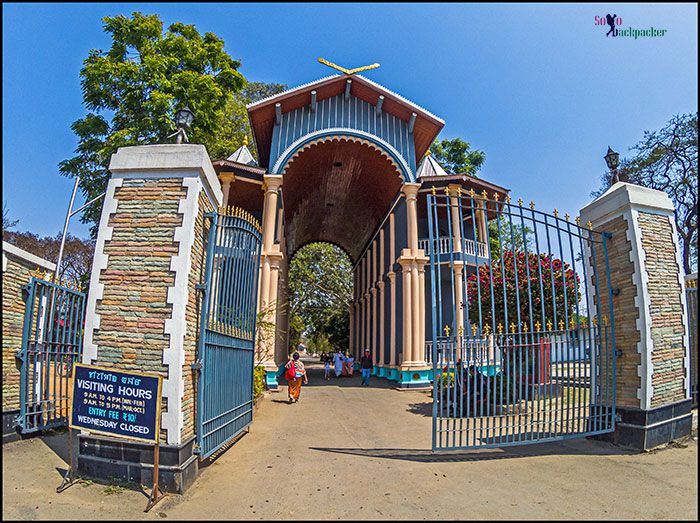
Subsequently, the fort is developed as a notable tourist attraction in Imphal. It is having a rich legacy of political and religions significance in Manipur. The main attractions inside the fort include the ruins of the ancient citadel, a glass house showcasing royal boats, Sanamahi Temple (dedicated to Lainingthou Sanamahi, the ancient deity of the Meitei), two giant statues of Kangla Sha (a mythological creature that is half-lion and half-dragon on the state Emblem of Manipur), the original Govindaji Temple, Kangla Museum and British-styled bungalow. The original temple of Govindaji is damaged and not under worship. However, the remnants of the grand pillars are able to indicate its ancient glory.
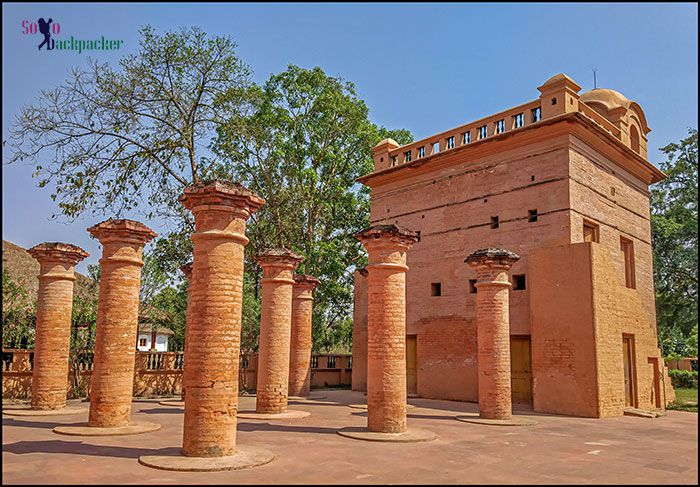
The complex is full of lush green gardens, colourful orchids, rose garden, blossoming cherry and other beautiful trees. The fort is surrounded by a moat (water canal) on three sides and Imphal river on the fourth side. Many water bodies are also present in the premises of Kangla Fort. The fort area is huge and can be tiresome. It is better to rent a bicycle or hire a golf cart from the entrance to visit the fort comfortably.
3. World War II Cemeteries in Imphal
It is fascinating to know how the remote part of British India like Nagaland and Manipur suddenly became the centre-stage of world politics during the World War II. During the WWII, it turned to a truly cosmopolitan area swarmed by the soldiers from India, African countries, USA, Britain, China, Japan, Burma, etc. In the battlefield of Kohima and Imphal, the Japanese Forces (supported by the Indian National Army) and the Allied Forces engaged in a remarkable war of the human history making North East India an important theater of the World War II.
Read here the other stories of World War II in North East India: Legacy Of The Stilwell Road
The memories of the World War II is scattered all around in the North Eastern States in the form of remote airfields, erected memorials and well-maintained cemeteries. Imphal also maintains two important cemeteries for World War II era, both maintained by Commonwealth War Graves Commission. One is known as Indian Army War Cemetery that consists the graves of the soldiers of Undivided India and few African Soldiers, while second one known as Imphal War Cemetery consists the graves of British, American and Indian soldiers from the British Army Division.
The Imphal War Cemetery was located near the main Kohima-Imphal road, just opposite to DM College of Science. The cemetery was begun during the war and more than 500 graves had been made by 1945. The cemetery is a final resting place for more than 1600 soldiers from Allied Forces, almost 140 of whom remain unidentified.
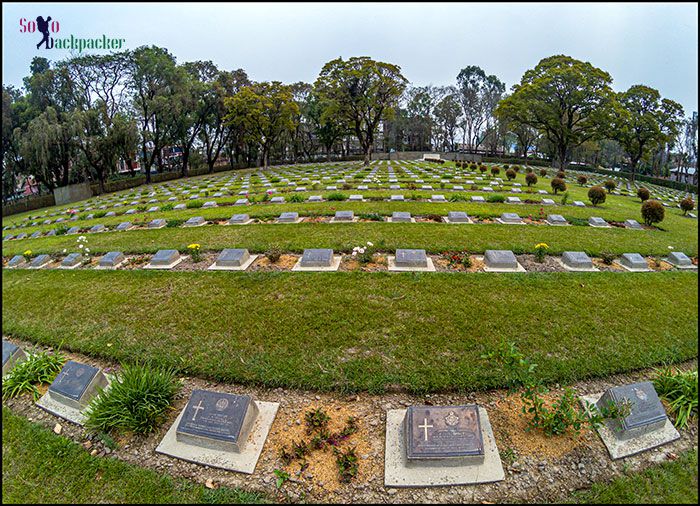
A stone plaque is put up at the each grave with the final messages from the family members. A plaque read as “Rest in peace Darling till we meet again.” On the grave of H.V.Turner, who was posthumously awarded the Victoria Cross, the plaque read as “Well Done, Good and Faithful Servant. Ever Remembered.” The unidentified graves are equally marked with dignity. One of the such plaque read as “ A Soldier of the 1939-1945 War. Known unto God.”The cemetery includes a memorial known as The Cross of Sacrifice. There is a small pool behind the memorial. A Stone of Remembrance is also built in a side of the cemetery.
The other one, Indian Army War Cemetery is located near Hafiz Hatta Masjid, across the Imphal River, if you approach from Kohima-Imphal road. The main approach through a narrow alley between the cluster of houses. The cemetery is green sprawling complex inside a walled enclosure with lovely trees and erected memorial. Burials and cremations at the cemetery were conducted during the war.
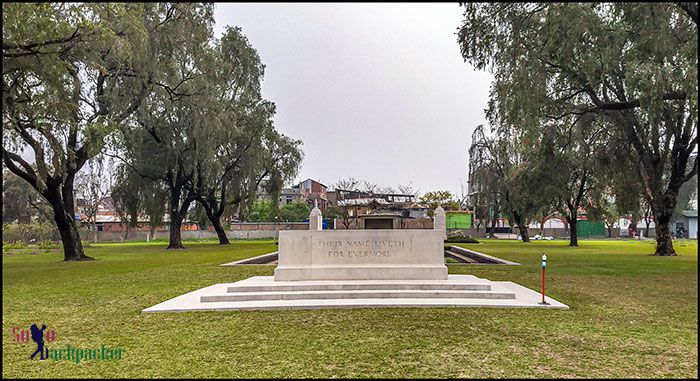
By 1945, over 300 men had been buried there and by 1947, the remains of more than 500 others had been brought from smaller sites across the area. The cemetery contains a memorial known as Imphal Cremation Memorial that commemorates nearly 870 Buddhist, Hindu and Sikh servicemen. It additionally has a Stone of Remembrance and pool behind the stone. The Grave of Jemadar Abdul Hafiz, who was posthumously awarded with Victoria Cross is marked here. The graves of unidentified soldiers read as “A Soldier of the Indian Army 1939-1945 is honoured here.”
4. Eco-Tourism Picnic Spot at Cheirao Ching
Imphal valley is a sort of bowl surrounded by the beautiful hills. Cheirao Ching is a perfect place to enjoy the breathtaking view of Imphal valley during the day as well as in the night. It is a newly developed attraction in Imphal as an Eco-Tourism Spot. Earlier it used to be a dusty trail to a hilltop for the hiking enthusiasts, but it is completely revamped now. The hillock is also developed with modern amenities and viewpoints.
The viewpoint offers a 360 degree panorama of Imphal city and surrounding areas including the Legislative Assembly Building. 40-45 minutes hike from the ground to the hill top looks tiring on a hot and humid day, but the view from the top is absolutely breathtaking, specially in the evening. The tourist trail is getting expanded towards the adjacent hilltop also. It’s a must visit attraction to enjoy the spectacular night views of Imphal city.
5. Shri Govindaji Temple
The temple is an absolute bliss in the city of Imphal. It is the largest Vaishnava temple in Imphal and located next to the palace of the former rulers of the then Manipur Kingdom, and at a walking distance from Kangla Fort as well Ima Market. It has many open spaces and a huge prayer hall. Bhojan Prasad is offered every day in traditional Manipuri style around 11 AM. The main idol installed is Radha Krishna in the middle, Krishna Balram on the left and Lord Jagannath, Balabhadra and Subhadra on the right.
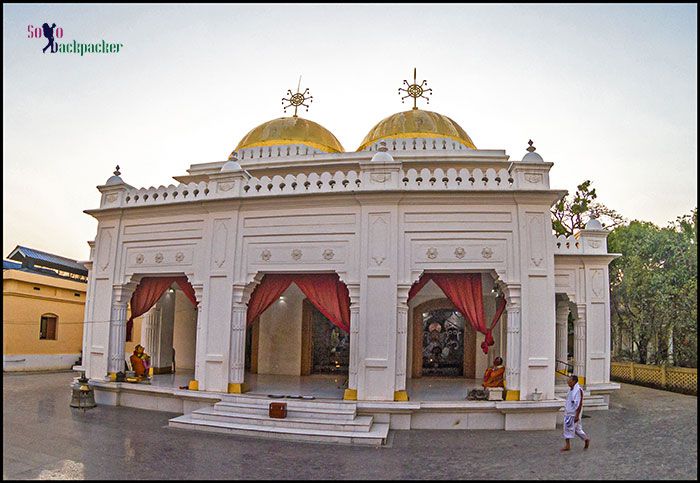
Sandhya Aarti (Evening Prayer) is a gorgeous ceremony, where you can see a soothing Aarti prayer with the help of local musical instruments in traditional Manipuri style with strict dress code for the performing devotees.
6. ISKCON Temple
I was not aware that Imphal had a beautiful and spectacular ISKCON Temple. While moving from the airport to the city, I fortunately found a sign-board indicating ISKCON Temple, just at a walking distance from the airport. The main entrance of the temple is still under construction. The temple is an architectural beauty and looks magnificent during the sunset. The dome shaped ceiling of the main prayer hall is adorned with the glimpses of Shri Krishna’s life.
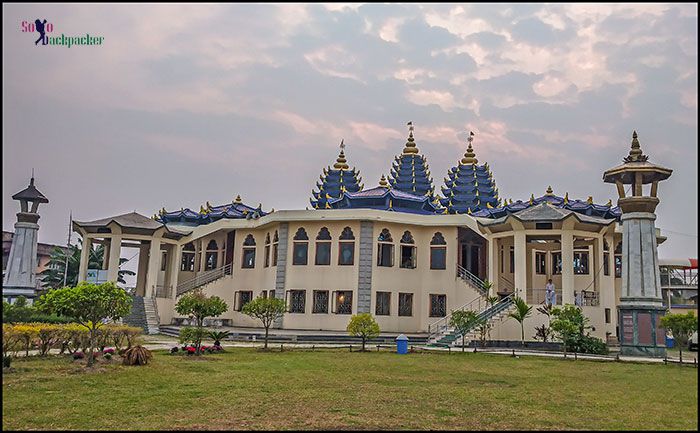
Heard that Morning and Evening Aarti are divine. There is a modest restaurant known as ‘Govinda’ where you can enjoy delicious Manipuri Thalis during the day. The temple is also available for performing the private ceremonies like family rituals, mundan, marriages, etc. A lush green garden lawn in front of the temple is still in development phase.
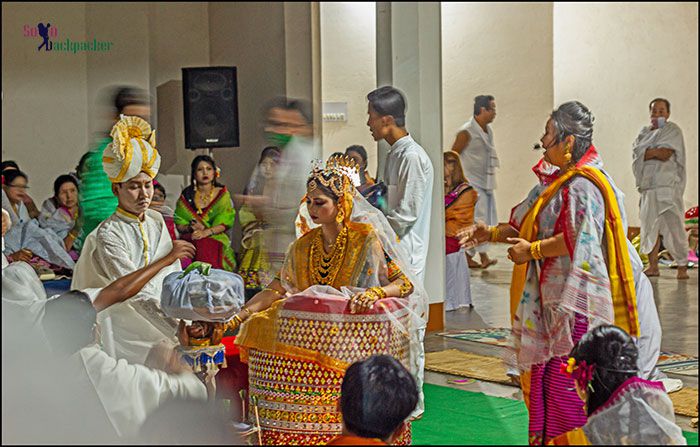
By a stroke of luck, I got an opportunity to attend a Manipuri wedding at the ISKCON Temple. When I reached there, a wedding ceremony was going on. With the permission of the elder people from the marriage party, I entered in the hall. The wedding ceremony is known as Luhongba. The groom dressed in all white- a white dhoti, kurta and a white turban with golden borders, while the bride was wrapped in a beautiful embroidered well decorated stiff skirt (Potloi) and ornaments. They sit around a Tulsi plant, where priest chants some mantras. I attended the ceremony for half an hour and moved out from the wedding hall.
7. Imphal Peace Museum
It is developed at the foothill of Red Hill in the 20 km Southwest of Imphal with the support of the Nippon Foundation (TNF), a non-profit grant-making organization in collaboration with Manipur Tourism Forum and Manipur Government in 2019. The Red Hill area was the epi-center of a fierce battle during the World War II.
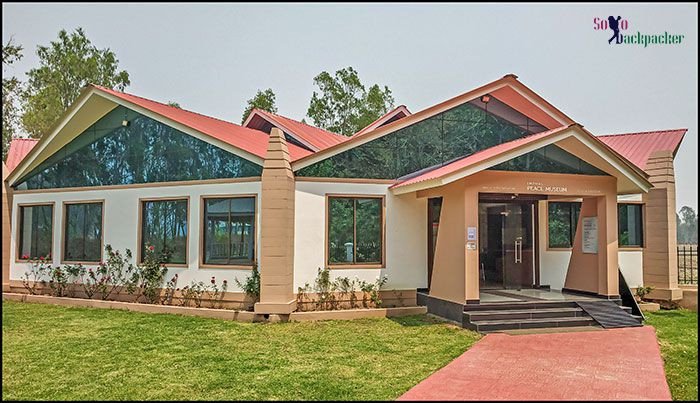
The thematic museum displays a timeline of the Battle of Imphal along with names of casualties in the war. The exhibits include artefacts of the war like artillery shells, personal notes of the soldiers, photographs, map of the battle of Imphal, army uniforms etc. Another section display the arts and cultural life of Manipur through the photographs and still models. There is a large assembly hall in the museum. Along the wall of the hall are the pictures of people from different communities in Manipur in their native dress. A large, glass-encased calligraphy with the characters for “heiwa” meaning “peace”, written by Japanese Prime Minister Shinzo Abe is also displayed in the museum.
8. Street of Momo Vendors
While moving around on roads in the evening, I came across a street near Manipur University of Culture in Angom Colony area, where many vendors sell the home-made momos. Few members of the local families establish these momo stalls everyday in the evening. You can see them rolling flour, filling stuffs and preparing momos on the street only. I tried momo at one of such stall, but couldn’t like the taste. Later, I tried one more shop and it was relatively better than the previous one, although not a great taste to satisfy my taste buds.
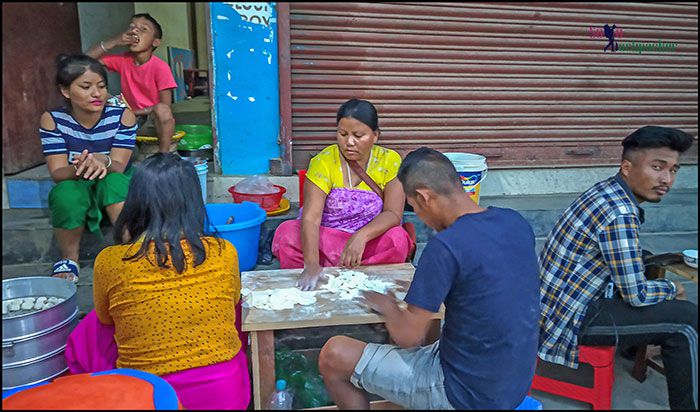
9. Sadu Chiru Waterfall
It is a beautiful waterfall on the outskirts of Imphal city, a brief detour from the Loktak Lake road, approx 20 km from the airport and 28 km from the youth hostel. The road is in good condition. The road passes through the small villages and paddy fields finally ascending through the hilly terrain. From the parking space, the waterfall can be reached trough a gradual climb on 500 m long trail of stone steps. The surrounding hills covered with the lush green forest looks mesmerizing. It is a pleasant place to take bath and enjoy the cool plunge of the waterfall. Keep in mind that there is no place to change the clothes near the waterfall, in case you decide to bath.
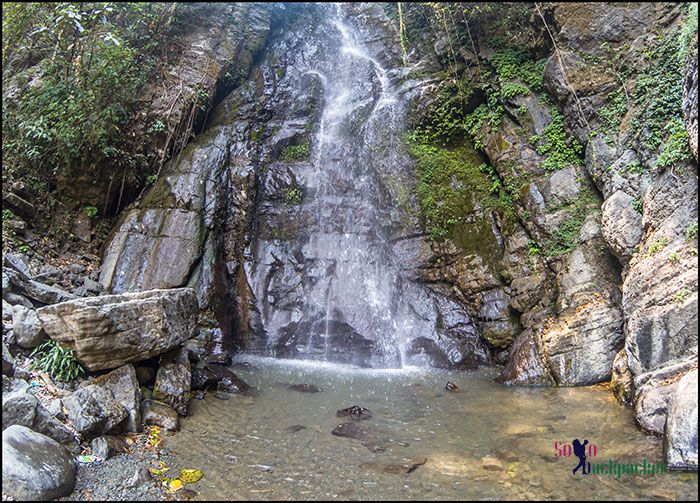
While returning from the waterfall, I came across a charming lady selling some liquid items in the colourful bottles. I asked her if that was the local beer, but she denied and said it was the local juices in different flavours like mango and strawberry. Though I can smell the powerful scent of fermentation that was indicating the stuffs were beer only. I asked her to give a small glass of Mango flavoured drink to try, she started pouring a litre country-made beer in a polybag, so that I could carry that with me. I stopped her and said to pour that only in a small cup, so that I could just taste. It was strongly fermented and ascertained they were the country-made beers.
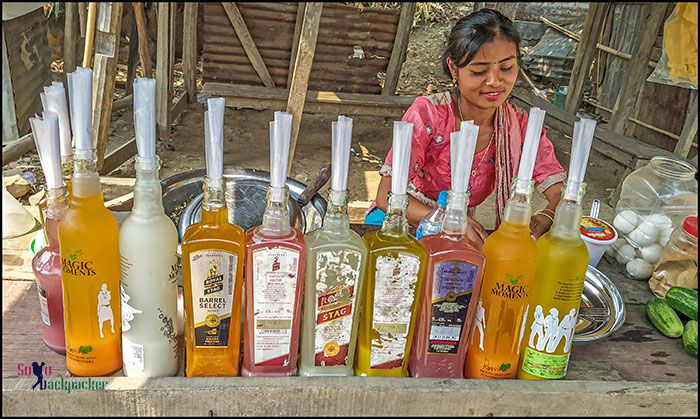
If you visit Sadu Chiru Waterfall in near future, you may also get a chance to try the country-made beers of different flavours. In fact, you can find many of the local tribal women selling these stuff as well as green vegetables, dry fish etc at the make-shift stalls along the Village Road.
10. Waroi Garden Picnic Spot
I saw a beautiful garden after 15 minutes of the ride from the waterfall while returning. It’s a well maintained picnic place with nice ambience. The place is very popular among the locals. There is small man-made lake to enjoy the boating as well the as kids playing area. A restaurant is there to enjoy the meals. You can even rent the utensils and buy the groceries to cook your own meal in the open area. The garden is a popular place for the photoshoot. I also came across a photoshoot during my visit to the garden.
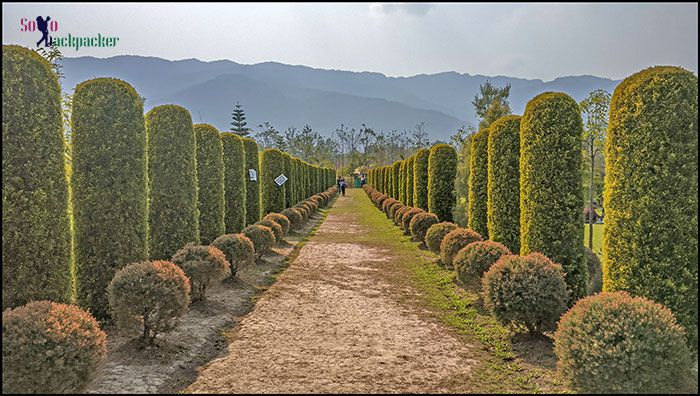
11. Strawberry Farms
I have never been to a Strawberry Farm, so when I got a chance to visit one such farm on the way to Sadu Chiru Waterfall, I gladly bumped on the opportunity. The farm is located near Nambol Bazaar and requires a detour of 4-5 km from the road to Sadu Chiru. I didn’t find red Strawberry fruits as they were still in growing stage. However, visiting Strawberry plantations was itself an experience. The Strawberry plantation process starts in September. By mid-November, the fruit is ready for harvest.
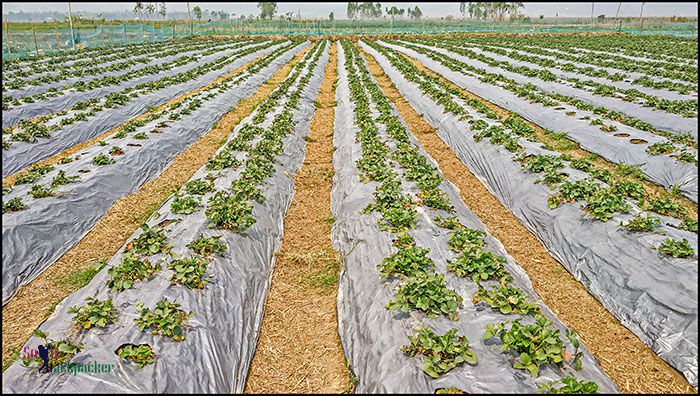
Apart from all these, Imphal also boasts the oldest Polo Ground (Mapal Kangjeibung) in the world. Polo, though popularised by the British, originated in Manipur. Moirang is just 45 km away from Imphal, where you can enjoy the breathtaking beauty of Loktak Lake, the brow-antlered deer or the dancing deer (popularly known as Sangai Deer) in the natural habitat at Keibul Lamjao National Park and the INA Museum.
12. How to Reach Imphal?
Manipur doesn’t has a railway line, so the road and the air connectivity is only option to reach Imphal. Due to the primarily hilly terrain around Imphal, the road network is not so well developed.
Road Connectivity to Imphal
For many years, the National Highway from Dimapur to Imphal via Kohima (NH 39) was the only lifeline to Manipur and the state’s over-dependence upon it is fully exploited by the insurgents not only through extortions along the highway but also through regular bandhs. The highway passes through the hill districts of Naga tribes and during the regional conflicts, the Naga unions have been organising prolonged bandhs on the highway to starve the Imphal valley of essential supplies. The cost of over-dependence upon this highway for the people of Manipur has been enormous.
इम्फ़ाल से आइजॉल की सड़क यात्रा के बारे में यहाँ पढ़ सकते हैं: इम्फ़ाल से आइजॉल की सड़क यात्रा
I travelled on both routes during my visit to Manipur. During the first trip, I travelled on Imphal-Jiribam-Silchar route and found it in much improved condition. The route is regularly patrolled by the security forces. Being the hostile area, one still has to pass through a number of security checkpoints on this route. The old bridge at Barak River is not in great shape, but the construction work is going on for the new one. The road is well-paved and pretty smooth between Jiribam and Silchar. Shared vehicles (Sumo, Cruiser etc) are available on this highway between Silchar and Imphal via Jiribam.
On the second trip, I travelled on NH 39 (now part of Asian Highway, AH1) from Imphal to Dimapur via Kohima. Except few km of stretch between Dimapur and Kohima and then between Kohima and Mao Gate, the road is in perfect condition. In fact, I came across a well maintained highway after entering in Manipur through Mao Gate and it was a smooth ride till Imphal. Shared vehicles (Sumo, Force Traveller, Buses etc) are available on this highway between Dimapur and Imphal via Kohima.
Air Connectivity to Imphal
Imphal International Airport is connected with the major cities of India (Delhi, Kolkata, Bengaluru, Mumbai etc) by the daily flights. There used to be a flight between Imphal and Mandalay in Myanmar, but that flight is terminated as of now. The airport was constructed during the World War II era and known as Tulihal Airstrip then. It was a major supply link for the allied forces who were fighting with the Japanese forces during the seizure of Imphal. Later, Tulihal Airstrip developed as a major airport in North East India and became the present day Imphal International Airport. Being the only airport in Manipur, it is also an important link to the India’s Look East Policy as the road connectivity is still a distant dream. The recent military coup in Myanmar just worsens the situation.
When I arrived at Imphal Airport first time in 2019, it was a beautiful morning of April. The flight from Kolkata to Imphal offers a spectacular vista of Loktak Lake during the landing approach. The terminal building looks beautiful with green-colored triangular small domes peeping out from the roof. The airport is surrounded by the hilly terrain. During the rainy season, the clouds descend in the valley making the surrounding very beautiful.
What surprised me was the connectivity of the airport with the city. I used to listen the stories from my seniors about the conflicts in Imphal. There was a time when they were not allowed to roam outside the airport because of the security concerns. Malom Bus Stand is just on the outskirts of the airport, where 10 people were killed by the soldiers of Assam Rifles in allegedly a fake encounter. The incident is known as “Malom Massacre” and prompted Irom Sharmila to start her hunger strike against the controversial AFSPA rule. Now, the airport is connected to the city centre of Imphal by a well connected highway, in fact, the city has been expanded upto the airport and it looks like a part of the Imphal City. You can easily get the city buses, auto-rickshaws and other vehicles to travel around without any security issue.
13. Public Transport in Imphal
An efficient network of public transport exists in Imphal in the form of the public buses and the shared autos. Shared autos are the preferred mode of transport in the city area, while buses are preferably used to commute between the districts.
14. Accommodation in Imphal
Imphal has a sufficient number of hotels, guest houses and home-stays for night stay. Most of the budget hotels are located near the starting point of Kohima road (Khuman Lumpak and around) and in Jiri Parking area near Ima Market. I personally prefer to stay at the Youth Hostel located near the Khuman Lumpak Stadium. The rooms at youth hostel are available at decent rates with all the basic amenities like hot water, mosquito net etc. Simple veg and non-veg meals are also available at the reasonable rates.


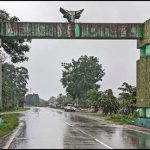
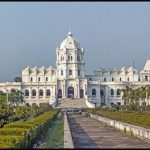
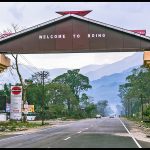
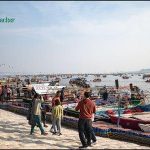
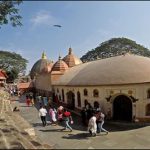
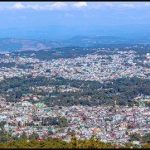
very good, realistic and useful information. Thank you Sir.
Not a jewel of Manipur Jewel Of India
Thanks for well written about Manipur. But heading of this writing is quite disturbing my mine. it may be sound apropos to say that ‘Jewel of India’ as famously said by the first Prime Minister of India instead Jewel of Manipur. It’s my personal view.
Regards
Hi, I loved visiting Imphal and definitely enjoyed my stay there during two trips. But, ‘Jewel of India’ looks a bit exaggerated in my personal opinion. There are many cities in the country to claim that title. Still, it’s a very nice destination.
thought I was reading about the public transport system in Imphal until I read Shillong has an efficient public transport. Guess Imphal’s transport system sucks n too embarassing to mention about it
Consider it as a typo error. Corrected. Thank you for pointing it out.
After so long time….When on the start I was reading I felt excited that you will write about Mizo then suddenly you wrote that you will write it later
Nice description of imphal and other places extensively
Thank you. Let me complete Manipur and Nagaland first, then I will start writing about Mizoram 🙂